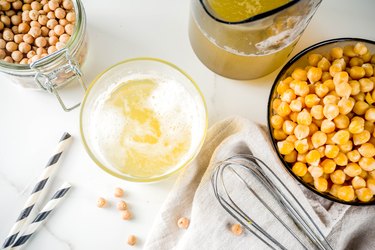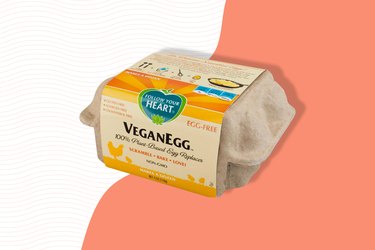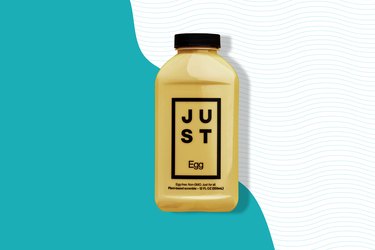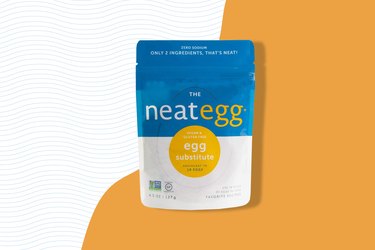
Eggs are a staple for cooking — and no wonder: They're packed with protein and provide a plethora of nutritional benefits. But for some people, eating an egg just isn't an option.
Sometimes that's due to allergies — the American College of Allergy, Asthma and Immunology states that 2 percent of children have an egg allergy, although the majority of them will outgrow the allergy in the teen years. Vegans choose not to eat eggs, and other people may avoid eating them for health reasons.
For decades, there's been a nutritional back-and-forth on whether eggs are really that good for you. While the breakfast staple hosts loads of benefits, there are also concerns about it, particularly when it comes to heart health. For instance, a March 2019 meta-analysis of six cohort studies published in JAMA found that eating an additional half an egg a day was associated with higher risks of heart disease and premature death.
Fortunately, there are plenty of options — some readily available in the pantry and others that are a bit more unusual — that can be used in place of an egg. Take a look at some of the egg substitute ingredients we love to use while baking and cooking.
1. Flax Egg
Many dietitians recommend flaxseeds as the go-to replacement for eggs. They contain fiber, protein, omega-3s and antioxidants, says Elizabeth Huggins, RDN at Hilton Head Health. One ounce of flaxseeds has 153 calories, 12 grams of healthy fat 8 grams of fiber, 5.3 grams of protein and 39 percent of your daily value (DV) of vitamin B1, according to the USDA.
How to make the substitution: To make one "flax egg," grind 1 tablespoon of flaxseeds and then whisk in 2 to 3 tablespoons of water, says Suzannah Gerber, executive chef of Haven Foods and author of Plant-Based Gourmet. Then, let the mixture sit for a few minutes until it congeals. "I keep the flaxseeds whole so they stay fresh, and grind them as needed," says Gerber.
When to use it: Try this egg alternative in quick breads, cakes, muffins and pancakes, recommends Gerber, who says it generally works well in baking.
Read more: Golden Flax Seed Vs. Brown Flax Seed
2. Applesauce or Mashed Banana
Mashed fruits — especially applesauce and bananas — are a good way to add moisture and sweetness, says Huggins.
Applesauce from one small apple has 47 calories, less than a gram of protein and 12.6 grams of carbohydrates with 1.2 grams of fiber, per the USDA. One small banana has 90 calories, 1 gram of protein and 23 grams of carbohydrates with 2.6 grams of fiber, according to the USDA. Bananas are also rich in potassium, says Huggins. (That small banana has 362 milligrams of the mineral!)
How to make the substitution: If you're using applesauce, combine one-fourth cup applesauce with 1 teaspoon baking powder in place of an egg, says Huggins. For bananas, use one-fourth cup mashed banana in place of one egg, says Gerber.
When to use it: Both apples and bananas are good choices when you want to replace the moisture that an egg provides, says Gerber. Try them with quick breads and muffins as the natural sweetness of the fruit will fit in with the recipe, says Huggins.
Gerber notes that applesauce can work well in brownies as long as a leavening agent (like baking soda) is provided. "Banana makes a good pie filling swap for things like pumpkin pie or even cream pies," says Gerber.
3. Chia Seeds
Like flax, chia seeds work well as a binder in baking, says Jill Nussinow, RDN, chef, cooking instructor and author of Vegan Under Pressure. And these tiny seeds are a real superfood: Two tablespoons of chia seeds provide 138 calories, 4.6 grams of protein, 9.75 grams of fiber and 179 milligrams of calcium (that's 14 percent of the DV), according to the USDA.
How to make the substitution: Combine 3 tablespoons of water and 1 tablespoon of ground chia seeds. You can also use a fifty-fifty mixture of flax and chia seeds, notes Gerber.
When to use it: Like flax seeds, chia seeds are ideal when you need a binding agent.
4. Vinegar + Baking Soda or Oil + Baking Soda
It's the stuff of school science experiments: Combine baking soda and vinegar, and you'll get a delightful fizz. This combo also happens to work well in baking as the mixture helps duplicate the leavening effect that eggs provide and helps your baked goods rise, says Nussinow.
Another option that promotes a good rise is the combination of baking powder and vegetable oil, which leads to light and fluffy baked goods.
How to use vinegar + baking soda: Mix together 1 teaspoon of baking soda with 1 tablespoon of vinegar.
How to use vegetable oil + baking soda: Combine 1 tablespoon of vegetable oil and 2 teaspoons of baking soda with 1 tablespoon of water.
When to use it: Try either combo with quick breads, recommends Nussinow. Note, however, that the combination of vinegar and baking soda will not help with binding ingredients together.
5. Yogurt
Yogurt is a protein-rich alternative to eggs that helps replace the moisture that egg provides to a recipe. One cup of plain, whole milk yogurt packs in 150 calories, 8 grams of fat, 11 grams of carbs and 8.5 grams of protein, per the USDA. If you're avoiding dairy, you can use soy yogurt, which usually contains less protein and more carbs than traditional yogurt.
How to make the substitution: Sub in one cup of plain yogurt or soy yogurt in place of an egg.
When to use it: Use yogurt in baked goods for extra moistness.
6. Agar-Agar
Looking to duplicate the binding effect that eggs provide? Turn to agar-agar, a plant-based gelatin substitute made from red algae. One-fourth of a teaspoon of agar-agar provides 1 gram of fiber and zero calories, sugar, fat or protein, according to the USDA.
How to make the substitution: Mix 1 tablespoon agar-agar powder with 3 tablespoons of warm water.
When to use it: Agar-agar is a good option for lemon curds and fruit gels, as well as some egg white applications, says Gerber. It's probably best avoided in baked goods, note Nussinow, since it may make them too dense.
7. Aquafaba
Most likely, you've discarded this substance many times while cooking. "Aquafaba is a viscous liquid that forms from soaking or cooking pulses (chickpeas, lentils, dry peas and beans)," Huggins explains. Instead of sending it down the drain, save this liquid and use it as an egg replacer. Aquafaba is a relatively new discovery, so nutritional information isn't readily available.
How to make the substitution: Drain the liquid in a can of legumes. In a stand mixer, whip it slowly until it foams and creates peaks (like an egg white would), says Gerber. Use 3 tablespoons of aquafaba in place of one egg.
When to use it: "Aquafaba is the dream of plant-based meringue eaters, for everything from mayonnaise to macarons," says Gerber. You can use it as a replacement for egg whites in a recipe that calls for them. To make a mousse, try whipping aquafaba on high for several minutes with a little bit of cream of tartar, vanilla extract and a sweetener such as agave, says Huggins.
8. Tofu
Both silken and firm tofu can serve as egg substitutes. According to the USDA, 3.5 ounces of silken tofu has 55 calories, 2.7 grams of fat and 5.8 grams of protein while a 3.5-ounce serving of firm tofu has 78 calories, 4.2 grams of fat and 9 grams of protein.
How to make the substitution: Purée, blend or mash one-fourth cup of silken tofu to replace one egg. And use 3 ounces of cubed firm tofu in place of one large egg, The Academy of Nutrition and Dietetics recommends.
When to use it: Gerber turns to silken tofu in custards and pie fillings. "I use firm seasoned tofu in place of egg whites in fried eggs," she says.
9. Nut Butter
"The sticky binding qualities of nut butters have made many vegan and raw desserts possible," says Gerber. Think: no-bake cookies. You can use any nut butter — cashew, almond or peanut — as a substitution for eggs. All are high in healthy fats and protein.
How to make the substitution: Use 3 tablespoons of the nut butter of your choice in place of one egg.
When to use it: Gerber recommends using nut butters in place of eggs in cookies or in a brownie recipe. Be aware: nut butter has big flavor. So only use this option if it will go well with the taste of your baked goods.
Read more: 6 Delicious No-Bake Desserts for Every Diet
10. Store-Bought Egg Replacements
If you don't have these egg substitute ingredients on hand — or want to skip the hassle of making them — you can turn to store-bought egg replacers. Gerber and Nussinow recommend the following options, which are available in most grocery stores.
Follow Your Heart VeganEgg

Follow Your Heart's VeganEgg is a great one-to-one replacement in baked goods, says Gerber, adding that, with seasoning, it makes for a good omelet or scramble. One two-tablespoon serving has 1 gram of fat, 150 milligrams of sodium, 5 grams of carbohydrates and 3 grams of protein.
Buy it: Amazon.com; Price: $17.36 per carton
JUST Egg

This cholesterol-free liquid egg replacer comes in a jar. One three-tablespoon serving of JUST Egg has 70 calories, 5 grams of fat, 170 milligrams of sodium, 1 gram of carbohydrates and 5 grams of protein coming mostly from mung bean protein.
Buy it: Amazon.com; Price: $6.99 per 12-ounce bottle
The Neat Egg

The Neat Egg is another great option for baking, says Gerber. Try it when you're replacing an egg that acts as a binding agent. A one-tablespoon serving contains 25 calories, 0 grams of fat, 4 grams of carbohydrates (with 2 grams of fiber) and 2 grams of protein.
Buy it: Amazon.com; Price: $8.44 per 4.5-ounce bag
Bob's Red Mill Egg Replacer

Gerber calls Bob's Red Mill Egg Replacer her "go-to for baking." This cholesterol-free powder 30 calories, 1 gram of fat, 20 milligrams of sodium, 2 grams of carbohydrates (1 gram of fiber) and 3 grams of protein per a one-tablespoon serving.
Buy it: Amazon.com; Price: $14.99 per 16-ounce bag
What to Consider When Swapping Eggs for Another Ingredient
Figuring out which egg alternative to use may require a bit of detective work. "What you'll use as an egg substitute depends upon what you are trying to do," says Nussinow. Gerber agrees: "The trick to replacing egg is knowing what the end goal is." Eggs can be used for binding, leavening or adding moisture, she says.
For binding: Try using chia or flax seeds.
For leavening: Opt for baking soda and water or agar-agar.
For moisture: Good options include bananas, applesauce or yogurt.
Making a batch of brownies?
Gerber suggests using apple cider vinegar, baking soda and applesauce — the ACV prevents the brownies from becoming too dense or sweet while the baking soda helps the brownies rise and the applesauce adds moisture. Yogurt is another good option, as are silken tofu, bananas and nut butter, which adds big flavor, too. Commercial replacers are also a good option if you’re whipping up brownies.